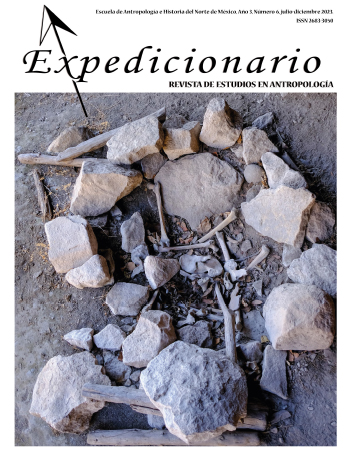Las palabras de los huesos en la memoria del sacrificio.
Tafonomía cultural en un depósito ritual de Tenochtitlan
Keywords:
Bioarqueología, Tafonomía cultural, Sacrificio, Mesoamérica, CuerpoAbstract
Cultural taphonomy processes are described and interpreted in the skeletal series of a ritual deposit located in the Sacred Precinct of Tenochtitlan and associated with Teotlachco. The central objective is the identification of the processes of cultural alteration in the bones to interpret them within the historical context of Tenochtitlan. The subsequent objectives are contained in the characterization of the archaeological context and the characterization of the skeletal series. Signs of cut marks, percussion and intentional fractures were identified, and they have been presented according to their frequency. An
association with sacrifice is inferred, indicating postmortem treatment of the body for ritual purposes.
Downloads
References
Barrera, R. (2019). Las exploraciones del Cuauhxicalco, el HueiTzompantli, el Templo de Ehécatl-Quetzalcóatl, la Cancha de Juego de Pelota y el Calmécac. En López Luján, L y Chávez, X (Coord), Al pie del Templo Mayor de Tenochtitlan. Estudios en honor de Eduardo Matos Moctezuma. El Colegio Nacional, México. Pp. 87-114
Behrensmeyer, A. K. y Kidwell, S. M. (1985). Taphonomy’s contributions to paleobiology. Paleobiology, (11). Pp. 105–119.
Bogin, B., Varea, C., Hermanussen, M. y Scheffler, C. (2018). Human life course biology: A centennial perspective of scholarship on the human pattern of physical growth and its place in human biocultural evolution. American Journal of Physical Anthropology. Pp. 834–854.
Chávez Balderas, X. (2007). Rituales funerarios en el Templo Mayor de Tenochtitlan. México: Instituto Nacional de Antropología e Historia.
Chávez Balderas, X. (2017). Sacrificio humano y tratamientos postsacrificiales en el Templo Mayor de Tenochtitlan (1a ed.). México: INAH.
Dehouve, D. (2007). La ofrenda sacrificial entre los tlapanecos de Guerrero (1st ed.). México: Universidad Autónoma de Guerrero/CEMCA/INAH/Plaza y Valdés.
Durkheim, E. (1982). Las formas elementales de la vida religiosa. España: Akal editor.
Goodman, A. H. y Martin, D. L. (2002). Reconstructing Health Profiles from Skeletal Remains. En R. L. Steckel y J. C. Rose (Eds.), The Backbone of History: Health and Nutrition in the Western Hemisphere. Pp. 11–60. Cambridge: Cambridge University Press.
Haglund, W. y Sorg, M. (2006). Method and Theory of Forensic Taphonomic Research. En W. Haglund y M. Sorg (Eds.), Forensic Taphonomy. The Postmortem Fate of Human Remains. Boca Raton: CRP PRESS, Tylor and Francis Group. Pp: 13-26.
Hubert, H. y Mauss, M. (1899). De la naturaleza y la función del sacrificio. Anné Sociologique. Pp. 143–248.
Kirchhoff, P. (1960). Mesoamérica: sus límites geográficos, composición étnica y caracteres culturales. Revista Tlatoani, suplemento, (3).
Klaus, H. D., Harvey, A. R. y Cohen, M. N. (Eds.) (2017). Bones of Complexity. Bioarchaeological Case Studies of Social Organization and Skeletal Biology. University Press of Florida.
Larsen, C. S. (2003). Bioarchaeology. Interpreting behavior from the human skeleton. United Kingdom, Cambridge University Press.
Larsen, C. S. (2006). The Changing Face of Bioarchaeology: An Interdisciplinary Science. En L. A. B. Jane E. Buikstra (Ed.), Bioarchaeology. The Contextual Analysis of Human Remains. United States of America, Routledge. Pp. 359–374.
López Austin, A. (2001). El núcleo duro, la cosmovisión y la tradición mesoamericana. En J. Broda y F. Báez-Jorge (Eds.), Cosmovisión, ritual e identidad de los pueblos indígenas de México. México, CONACULTA-Fondo de Cultura Económica. Pp. 47–65.
López Austin, A. (2016). Sobre la cosmovisión. Arqueología Mexicana (68). Pp. 8–24.
López Austin, A. y López Luján, L. (2001). El pasado indígena (2a ed.). México: Fideicomiso Historia de las Américas/Fondo de Cultura Económica.
Martin, D. L., Harrod, R. P. y Pérez, V. R. (2013). Bioarchaeology. An Integrated Approach to Working with Human Remains. Nueva York, Springer.
Meindl, R. y Lovejoy, O. (1985). Ectocranial Suture Closure: A Revised Method for the Determination of Skeletan Age at Death Based on the Lateral-Anterior Sutures. American Journal of Physical Anthropology 1, Pp. 57–66.
Pijoan Aguadé, C. M. (2019). Evidencias de sacrificio humano y canibalismo en restos óseos. El caso del entierro 14 de Tlatelolco, Ciudad de México (primera ed). México: Secretaría de Cultura/Instituto Nacional de Antropología e Historia.
Pijoan, C., y Lizarraga, X. (2004). Tafonomía: una mirada minuciosa a los restos mortuorios. En C. Pijoan y X. Lizarraga (Eds.), Perspectiva tafonómica. México: INAH (Colección Científica). Pp. 13-34.
Pijoan, C., & Pastrana, A. (1987). Método para el registro de marcas de corte en huesos humanos. México.
Romano, A. (1974). Sistemas de enterramiento. En J. Romero (Ed.), Antropología física, época prehispánica, 3. Pp. 83–112. México: Instituto Nacional de Antropología e Historia.
Saul, F. (1972). The Human Skeletal Remains of Altar de Sacrificios and Osteobiographic Analysis (núm. 2). Estados Unidos, Harvard University Press.
Shiffer, M. B. (1990). Contexto arqueológico y contexto sistémico. Boletín de Antropología Americana, Pp. 81–93.
Steckel, R. H., Larsen, C. S., Roberts, C. A. y Baten, J. (Eds.) (2018). The Backbone of Europe. Health, Diet and Violence over Two Millenia. Cambridge University Press.
Steckel, R. H., Larsen, C. S., Sciulli, P. W. y Walker, P. L. (2018). Data Collection Codebook. En R. H. Steckel, C. S. Larsen, C. A. Roberts y J. Baten (Eds.), The Backbone of Europe. Health, Diet, Work and Violence over Two Millenia, Cambridge University Press. Pp. 397–427.
Trejo Rosas, I. (2017). Informe de supervisión en predio Guatemala (núm. 16). México.
Ubelaker, D. H. (1989). Human Skeletal Remains. Washington: Smithsonian Institution Press.
Walker, P. L. (2008). Sexing Skulls Using Discriminant Function Analysis of Visually Assesed Traits. American Journal of Physical Anthropology, Pp. 39–50.
Witwer-Backofen, U. y Engel, F. (2018). The History of European Oral Health. In R. H. Steckel, C. S. Larsen, C. A. Roberts, y J. Baten (Eds.), The Backbone of Europe. Health, Diet, Work and Violence over Two Millenia. Cambridge University Press. Pp. 84–136.
Downloads
Published
Issue
Section
License
Copyright (c) 2023 Instituto Nacional de Antropología e Historia

This work is licensed under a Creative Commons Attribution-NonCommercial 4.0 International License.



